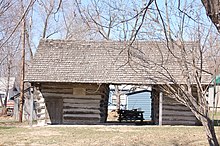17:
29:
96:. The doors in this type of crib barn face either front or in, toward the breezeway. The loft, as is typical with crib barns that have lofts, is used for storage of feed and hay in this design of crib barn while the first floor is used for stabling. The breezeway, which essentially acted as a driveway which entered the barn was often used for threshing grain.
32:
Double-cantilever, two-crib barn at the Tipton Place in Cades Cove, Great Smokey
Mountain National Park, in East Tennessee. The cantilever barn design, which is Western European in origin, is common throughout Southern Appalachia but rare elsewhere in North America. National Register of Historic
91:
The most popular type of crib barn built in the
Appalachian states was also the simplest to construct considering its size and stability. The "Double Crib" consisted of two cribs separated by a breezeway and covered by the same roof. This type of barn is the most common in
72:, which gained popularity in American agriculture. Crib barns were most often built of unchinked logs and may or may not have included a hay loft depending on the specific barn. Unaltered examples of crib barns usually have roofs covered with undressed wood
178:
150:
173:
157:, Digital Library of Appalachia, Appalachian College Association Central Library. Retrieved 7 February 2007.
138:, Preservation Briefs, National Park Service, first published October 1989. Retrieved 7 February 2007.
44:
found throughout the U.S. south and southeast regions. Crib barns were especially ubiquitous in the
64:
pens. Crib barn construction was somewhat simplistic compared to other types of barns, such as the
52:
states of North
Carolina, Virginia, Kentucky, Tennessee, Missouri, East Oklahoma and Arkansas.
135:
45:
60:
These barns were composed of multiple cribs, up to six, which were used for feed storage or
8:
21:
147:
154:
105:
49:
167:
110:
115:
73:
65:
16:
93:
69:
28:
61:
85:
81:
41:
148:
Historical Survey of Log
Structures in Southern Appalachia
77:
88:
appearance of crib barns that cause them to stand out.
24:
U.S.A. National
Register of Historic Places 79001344
179:Log buildings and structures in the United States
165:
27:
15:
76:, which, over time, were replaced with
166:
13:
141:
136:The Preservation of Historic Barns
128:
14:
190:
1:
121:
7:
99:
10:
195:
174:Barns in the United States
55:
40:were a popular type of
20:Reese Family Log Barn,
34:
25:
31:
19:
153:2007-02-06 at the
35:
26:
22:Novinger, Missouri
134:Auer, Michael J.
186:
158:
145:
139:
132:
194:
193:
189:
188:
187:
185:
184:
183:
164:
163:
162:
161:
155:Wayback Machine
146:
142:
133:
129:
124:
102:
58:
33:Places 77000111
12:
11:
5:
192:
182:
181:
176:
160:
159:
140:
126:
125:
123:
120:
119:
118:
113:
108:
106:Timber framing
101:
98:
57:
54:
50:Ozark Mountain
9:
6:
4:
3:
2:
191:
180:
177:
175:
172:
171:
169:
156:
152:
149:
144:
137:
131:
127:
117:
114:
112:
111:Dogtrot house
109:
107:
104:
103:
97:
95:
89:
87:
83:
79:
75:
71:
67:
63:
53:
51:
47:
43:
39:
30:
23:
18:
143:
130:
116:Log building
90:
84:. It is the
66:prairie barn
59:
37:
36:
46:Appalachian
168:Categories
122:References
94:Appalachia
70:round barn
38:Crib barns
62:livestock
151:Archived
100:See also
74:shingles
82:asphalt
68:or the
86:rustic
56:Design
48:and
42:barn
80:or
78:tin
170::
Text is available under the Creative Commons Attribution-ShareAlike License. Additional terms may apply.

